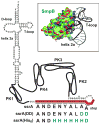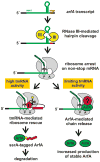The tmRNA ribosome-rescue system
- PMID: 22243584
- PMCID: PMC3358797
- DOI: 10.1016/B978-0-12-386497-0.00005-0
The tmRNA ribosome-rescue system
Abstract
The bacterial tmRNA quality control system monitors protein synthesis and recycles stalled translation complexes in a process termed "ribosome rescue." During rescue, tmRNA acts first as a transfer RNA to bind stalled ribosomes, then as a messenger RNA to add the ssrA peptide tag to the C-terminus of the nascent polypeptide chain. The ssrA peptide targets tagged peptides for proteolysis, ensuring rapid degradation of potentially deleterious truncated polypeptides. Ribosome rescue also facilitates turnover of the damaged messages responsible for translational arrest. Thus, tmRNA increases the fidelity of gene expression by promoting the synthesis of full-length proteins. In addition to serving as a global quality control system, tmRNA also plays important roles in bacterial development, pathogenesis, and environmental stress responses. This review focuses on the mechanism of tmRNA-mediated ribosome rescue and the role of tmRNA in bacterial physiology.
Copyright © 2012 Elsevier Inc. All rights reserved.
Figures




Similar articles
-
Emerging views on tmRNA-mediated protein tagging and ribosome rescue.Mol Microbiol. 2001 Nov;42(4):879-85. doi: 10.1046/j.1365-2958.2001.02701.x. Mol Microbiol. 2001. PMID: 11737633 Review.
-
Proteobacterial ArfA peptides are synthesized from non-stop messenger RNAs.J Biol Chem. 2012 Aug 24;287(35):29765-75. doi: 10.1074/jbc.M112.374074. Epub 2012 Jul 12. J Biol Chem. 2012. PMID: 22791716 Free PMC article.
-
tmRNA regulates synthesis of the ArfA ribosome rescue factor.Mol Microbiol. 2011 Jun;80(5):1204-19. doi: 10.1111/j.1365-2958.2011.07638.x. Epub 2011 Mar 30. Mol Microbiol. 2011. PMID: 21435036 Free PMC article.
-
Stepping transfer messenger RNA through the ribosome.J Biol Chem. 2005 May 6;280(18):18368-74. doi: 10.1074/jbc.M409094200. Epub 2005 Feb 15. J Biol Chem. 2005. PMID: 15713678
-
The tmRNA system for translational surveillance and ribosome rescue.Annu Rev Biochem. 2007;76:101-24. doi: 10.1146/annurev.biochem.75.103004.142733. Annu Rev Biochem. 2007. PMID: 17291191 Review.
Cited by
-
Evolutionary patterns of Escherichia coli small RNAs and their regulatory interactions.RNA. 2014 Jul;20(7):994-1003. doi: 10.1261/rna.043133.113. Epub 2014 May 27. RNA. 2014. PMID: 24865611 Free PMC article.
-
Distinct tmRNA sequence elements facilitate RNase R engagement on rescued ribosomes for selective nonstop mRNA decay.Nucleic Acids Res. 2014;42(17):11192-202. doi: 10.1093/nar/gku802. Epub 2014 Sep 8. Nucleic Acids Res. 2014. PMID: 25200086 Free PMC article.
-
Widespread ribosome stalling in a genome-reduced bacterium and the need for translational quality control.iScience. 2021 Aug 16;24(9):102985. doi: 10.1016/j.isci.2021.102985. eCollection 2021 Sep 24. iScience. 2021. PMID: 34485867 Free PMC article.
-
ClpX Is Essential and Activated by Single-Strand DNA Binding Protein in Mycobacteria.J Bacteriol. 2021 Jan 25;203(4):e00608-20. doi: 10.1128/JB.00608-20. Print 2021 Jan 25. J Bacteriol. 2021. PMID: 33229461 Free PMC article.
-
Overcoming stalled translation in human mitochondria.Front Microbiol. 2014 Jul 18;5:374. doi: 10.3389/fmicb.2014.00374. eCollection 2014. Front Microbiol. 2014. PMID: 25101074 Free PMC article.
References
-
- Abe T, Sakaki K, Fujihara A, Ujiie H, Ushida C, Himeno H, Sato T, Muto A. tmRNA-dependent trans-translation is required for sporulation in Bacillus subtilis. Molecular Microbiology. 2008;69:1491–1498. - PubMed
-
- Abo T, Ueda K, Sunohara T, Ogawa K, Aiba H. SsrA-mediated protein tagging in the presence of miscoding drugs and its physiological role in Escherichia coli. Genes to Cells. 2002;7:629–638. - PubMed
Publication types
MeSH terms
Substances
Grants and funding
LinkOut - more resources
Full Text Sources
Other Literature Sources
Molecular Biology Databases

